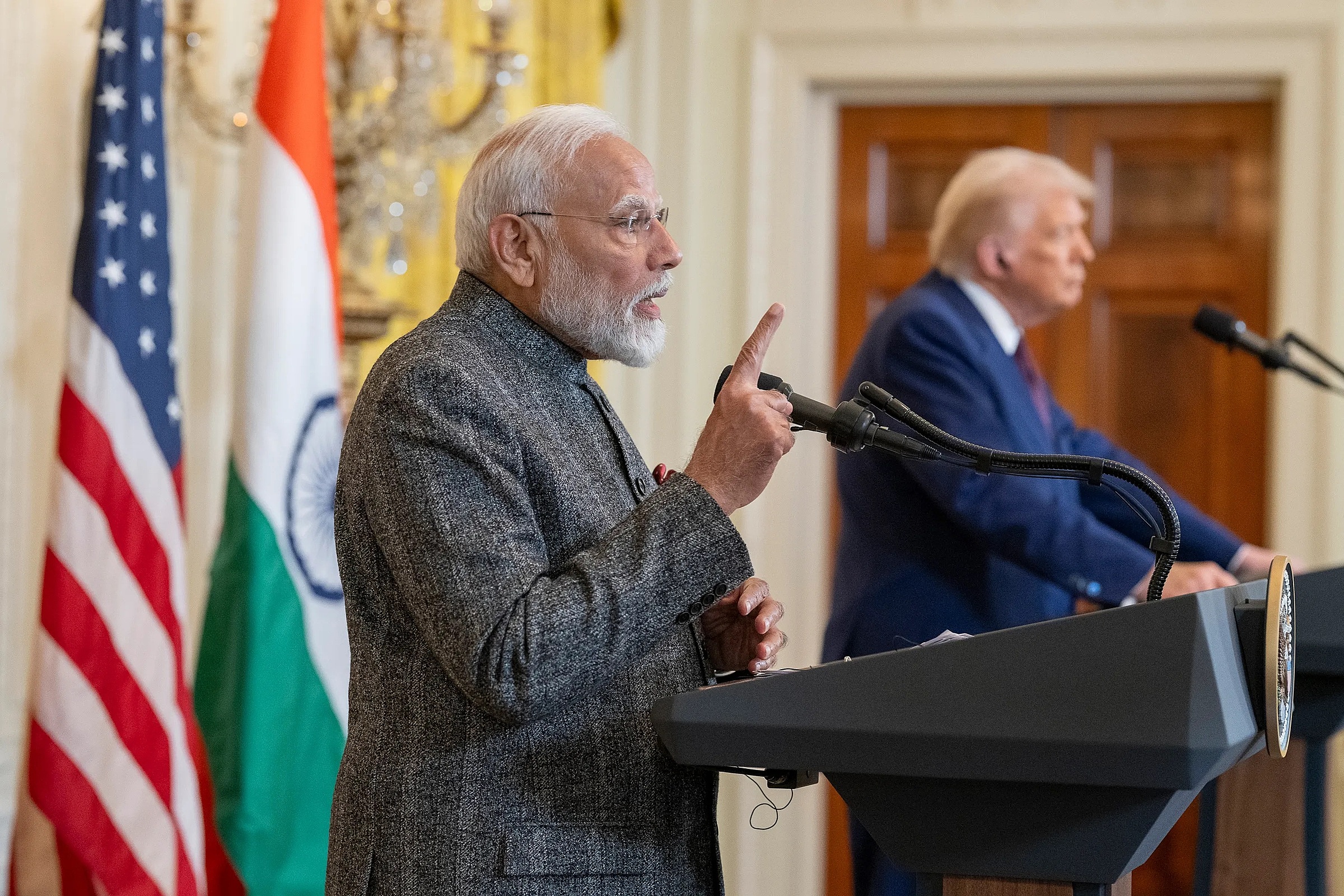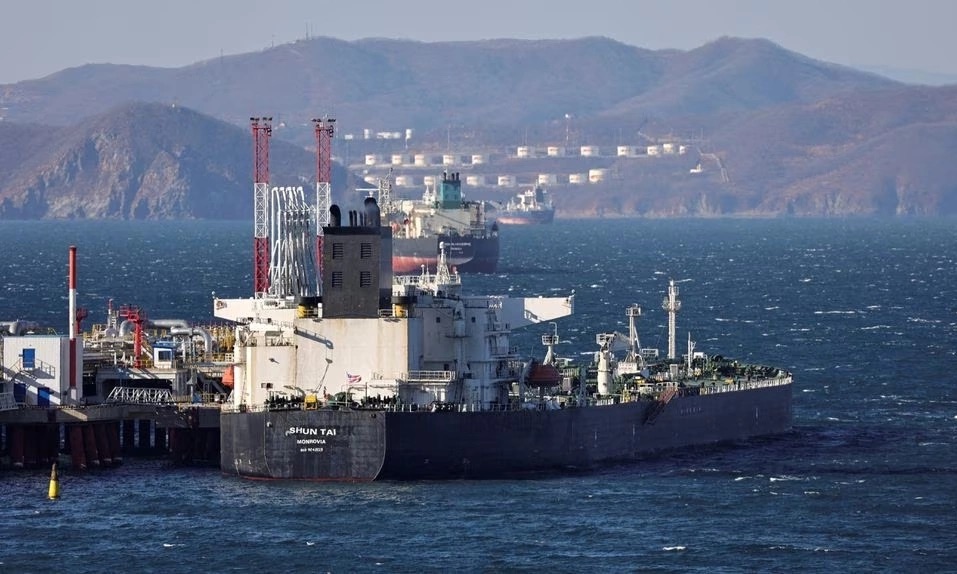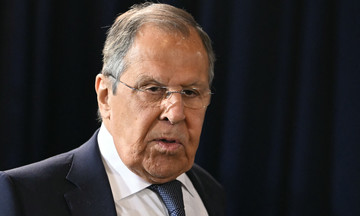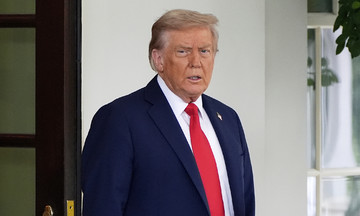Six years after a joint appearance at a major event in Texas, the relationship between President Donald Trump and Indian Prime Minister Narendra Modi has become strained due to India's purchase of Russian oil.
On 6/8, Trump announced a 25% tariff increase on Indian imports, bringing the total to 50%. This followed his unsuccessful call for India to halt its Russian oil purchases.
While many countries are vying for trade deals with the Trump administration, India, the world's 5th largest economy, has firmly rebuked the tariffs as "unfair" and declared it will continue buying Russian oil. India points out that the US and Europe still purchase goods like fertilizer and chemicals from Russia despite sanctions.
Observers note that Modi has compelling reasons to resist US pressure and maintain access to Russian oil.
 |
Indian Prime Minister Narendra Modi during a joint press conference with US President Donald Trump at the White House in 2/2025. Photo: White House |
Indian Prime Minister Narendra Modi during a joint press conference with US President Donald Trump at the White House in 2/2025. Photo: White House
With a population exceeding 1.4 billion, India is the third largest global oil consumer and is projected to surpass China by 2030, according to Reuters. India needs substantial crude oil supplies to sustain its economic growth and meet its population's needs.
Russia is the world's third largest crude oil producer at 11 million barrels per day, trailing only the US and Saudi Arabia, according to the US Energy Information Administration. After the Ukraine conflict began in 2/2022, many European nations reduced Russian oil imports and imposed sanctions on Moscow. Consequently, Russia redirected its oil flow towards Asia, with China and India as major customers.
Before 2022, Russian oil comprised only 0.2% of India's imports. However, Muyu Xu, a senior oil analyst at Kpler, notes that Russian crude now accounts for 36% of India's total imports in the first six months of this year, making Moscow its top supplier.
Amitabh Singh, an associate professor at the Centre for Russian and Central Asian Studies at Jawaharlal Nehru University (JNU) in New Delhi, explains that India's increased purchase of Russian oil is partly driven by substantial discounts from Moscow, "something traditional oil and gas suppliers can hardly offer."
"India's continued purchase of Russian oil is a purely economic or commercial decision," Singh said.
"Indian refineries are saving around one billion USD monthly by purchasing Russian crude," said Pramit Pal Chaudhuri, head of the South Asia division at Eurasia Group.
India not only needs affordable Russian crude oil for domestic energy needs, but also uses it to profit from refined petroleum products like diesel and jet fuel. Europe is one of India's largest markets for these products.
While India has diversified its oil supply over the years, completely abandoning Russian crude oil would create a difficult gap to fill. India imports up to 80% of its oil needs, as domestic production falls short of demand.
India's alternatives to Russian oil are limited. Previously, they had to stop purchasing oil from Iran and Venezuela after Trump imposed sanctions and threatened tariffs on those trading with the two countries. Before halting purchases, India was one of Iran's largest customers.
"Our hands are tied. The Indian economy or oil market has very little room to maneuver," Singh said.
 |
An oil tanker anchored at Kozmino port, Nakhodka Bay, near the city of Nakhodka, Russia, in 12/2022. Photo: Reuters |
An oil tanker anchored at Kozmino port, Nakhodka Bay, near the city of Nakhodka, Russia, in 12/2022. Photo: Reuters
Beyond economics, analysts suggest Modi's administration has other reasons to continue purchasing Russian oil.
"Buying Russian crude and refining it for export not only generates profit for India but also helps maintain political and economic ties with Moscow," said Manjari Chatterjee Miller, a senior fellow at the Council on Foreign Relations.
India and Russia have maintained multifaceted cooperation for decades, making it difficult for New Delhi to sever ties with Moscow entirely, despite pressure from Washington, according to analysts. India is also Russia's largest arms importer.
Furthermore, India seems to believe that the threat regarding Russian oil is merely a pretext for Trump to increase pressure on New Delhi to reduce high tariffs and open its agricultural and dairy markets to the US.
"New Delhi believes Trump's tariff threats are being used as leverage for concessions to secure a trade deal favorable to the US," said Dr. Chietigj Bajpaee, a South Asia expert at Chatham House.
Zac Weisz, an analyst at GZERO, also believes that since India sees Trump's move as a "negotiating tactic," Modi has no reason to concede.
Trump's threats have also irked some in India, particularly his earlier remark calling India's economy "dead." This statement drew strong reactions from the Indian public and politicians.
Indian Minister of Commerce and Industry Piyush Goyal affirmed that India is one of the fastest-growing economies globally and has the potential to become the third largest. International organizations like the IMF still project India's GDP growth between 6.2% and 6.8% for the 2025-2026 fiscal year.
Ashok Malik, a member of The Asia Group consulting firm and former policy advisor at the Indian Ministry of External Affairs, believes Trump's statements are "offensive and have undoubtedly tarnished his image in India." He adds that Modi will therefore feel the need to "respond."
Miller assesses India's firm stance as reflecting New Delhi's long-standing position of avoiding external interference and upholding its policy of "non-alignment" with any major power.
"India conceding to US tariff threats and reducing cooperation with Russia would certainly displease the public, which would weaken Modi's image," Miller said.
Thuy Lam (According to CNN, GZERO, CNBC)












